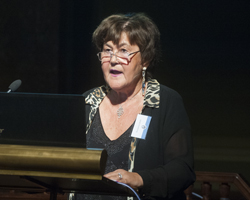Commemorating the impact of Semmelweis’ work on global health

Hungarian Academy of Sciences
The year 2018 has been designated the Ignác Semmelweis Memorial Year in Hungary. It marks the 200th anniversary of the birth of the man credited with saving more lives than any other physician in history. Semmelweis’s discoveries and achievements, including the introduction of effective handwashing protocols for medical procedures, brought about a new paradigm in infection control. His work on germ theory is just as relevant today as it was in the 1840s.
To celebrate the legacy of this outstanding scientist, the Hungarian Academy of Sciences, under the patronage of the President of Hungary János Áder and in collaboration with Semmelweis University in Budapest, hosted the opening ceremony of the Ignác Semmelweis Memorial Year on 5 June 2018.
In his opening remarks, President Áder highlighted the importance of pursuing truth in science, taking risks, benefitting patients rather than institutions, breaking habits and remaining curious about new facts for any scientific pursuit, including medicine.
In her presentation, Dr Zsuzsanna Jakab, WHO Regional Director for Europe, focused on Semmelweis’s impact on today’s global health priorities – especially on health care-associated infections; antimicrobial resistance; hand hygiene; clean water and sanitation; maternal, infant and child mortality; and early childhood development. Semmelweis’s legacy can also be linked to broader health and development priorities such as health status, equity and universal health coverage.
“Prevention is more effective and efficient than treatment. Semmelweis has proven this to the world,” said Dr Jakab. She emphasized that the case for investing in prevention becomes clear and imperative when the evidence shows how a simple intervention, like that championed by Semmelweis, is able to save maternal lives, reduce premature mortality, improve life expectancy and extend healthy years of life. The message about the importance of prevention is as relevant today as it was in Semmelweis’s time – out of the sizable health care budget, only 3% is spent on prevention in Europe.
The conference also included presentations by leading officials of the Pasteur Institute of Paris, France, the Federation of European Academies of Medicine, Vienna General Hospital (AKH) and the Berlin Museum of Medical History at the Charité. All highlighted the importance of engaging in professional exchange, of sharing scientific evidence, and of appreciating innovation as the means to improve and bring forward achievements in health sciences.
The legacy of Semmelweis
In the mid-19th century, about 5 in 1000 women died in childbirth through deliveries performed by midwives or at home. Yet when doctors working in the best maternity hospitals in Europe and America performed deliveries, the maternal death rate was often as high as one third of all deliveries.
Postoperative sepsis infections accounted for the death of almost half of the patients undergoing major surgery. Medical students and their professors at the elite teaching hospitals of this era typically began their day by performing barehanded autopsies on the women who had died the day before of puerperal (childbed) fever and other patients who died of sepsis. They then proceeded to the wards to examine the women in labour. The reason for the high death rate may seem readily apparent today, but it was not clear at that time.
For the first time in the history of medicine, Semmelweis ordered his medical students and junior physicians to wash their hands in a chlorinated lime solution until the smell of the corpses was no longer detectable. Soon after instituting this protocol in May 1847, mortality rates in the doctor-dominated obstetrics wards plummeted. It was not until 1865 that the microscope was invented that allowed Louis Pasteur and Joseph Lister to confirm the genius of Semmelweis.
At the event in Budapest, Dr Jakab announced that WHO has accepted the offer from the Faculty of Medicine at the University of Szeged and Semmelweis University to donate a bust of Semmelweis to the Organization. The formal unveiling ceremony will take place later this year at WHO headquarters in Geneva, Switzerland.



